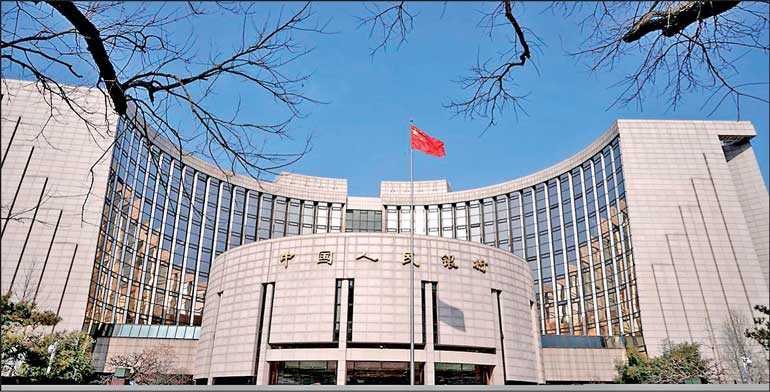Thursday Apr 03, 2025
Thursday Apr 03, 2025
Friday, 21 February 2020 00:00 - - {{hitsCtrl.values.hits}}

SHANGHAI/TOKYO (Reuters): China cut the benchmark lending rate on Thursday, as widely expected, as the authorities move to lower financing costs for businesses and support an economy jolted by a severe coronavirus outbreak.
The epidemic has upended global supply chains and caused widespread disruption to businesses and factory activity in China, prompting authorities to deliver a steady stream of policy measures over recent weeks to cushion the blow to growth.
The one-year loan prime rate (LPR) CNYLPR1Y=CFXS, the new benchmark lending gauge introduced in August, was lowered by 10 basis points to 4.05% from 4.15% at the previous monthly fixing.
The five-year LPR CNYLPR5Y=CFXS was lowered by 5 basis points to 4.75% from 4.80%.
All 51 respondents in a Reuters snap survey had expected a reduction in the LPR, with 38 respondents, or about 75% of participants, tipping a 10 basis points cut to both tenors. The LPR cut followed a similar move in the central bank’s medium-term lending rate on Monday. Investors are betting the authorities will roll out more monetary easing and fiscal stimulus in the near term to help smaller businesses that are struggling to tide over the crisis.
Mayank Mishra, macro strategist at Standard Chartered Bank in Singapore, said the LPR cut may not be enough to overcome the economic impact of the virus.
“The Chinese authorities are sending a message that easing will happen, but it will happen at a measured pace. They do not want fuel expectations that they will be easing aggressively,” Mishra said.
“We expect more monetary easing in the form of 100 basis points in the reserve requirement ratio (RRR) and 10 basis points in the medium-term lending facility (MLF) in addition to what we’ve already seen.” China’s yuan CNY=CFXS weakened to a more than two-month low against the dollar after the LPR cut, mainly pressured by further easing expectations.
Jacqueline Rong, senior China economist at BNP Paribas in Beijing, said she had expected a deeper cut to one-year LPR especially as interbank market rates have already posted sharp declines in the past month.
Banks are already setting lending rates well below the benchmark and if government subsidies are taken into account, some borrowers may not pay any interest at all, sources told Reuters.
Some analysts say the minor cut to the 5-year LPR likely signalled that authorities wanted to avoid stoking a property bubble and causing more damage to the economy in the longer run.
Smaller firms squeezed
The People’s Bank of China (PBOC) has pledged to use tools such as targeted reserve requirement cuts, relending and rediscount, to support key sectors affected by the outbreak, having already injected over $ 200 billion in liquidity in a bid to help lower financing cost.
China reported a dramatic drop in new cases in the province at the heart of the coronavirus outbreak on Thursday, though the death toll so far at over 2,000 has made it one of the biggest global health emergencies in recent decades.
The world’s second-biggest economy, already grappling with growth at its weakest in almost three decades as a trade war with the United States took its toll, had shown some signs of stabilisation just before the epidemic hit.
When compared with a year earlier, first-quarter growth could slump to 4.5% from 6.0% in the fourth quarter, according to the latest Reuters poll. Some analysts warn of even lower growth closer to the 3% mark, underlining the widespread business disruption caused by the virus.
The LPR is a lending reference rate set monthly by 18 banks. The PBOC revamped the mechanism to price LPR in August 2019, loosely pegging it to the medium-term lending facility rate.
Julian Evans-Pritchard, senior China economist at Capital Economics, warned that policy easing steps will only be of modest help for small firms – a key part of the economy.
“While more easing is likely in the coming weeks, this alone won’t change the fortunes of the millions of small firms suffering from the coronavirus outbreak,” he said.
“Surveys suggest that one-third of these firms may run out of cash in the coming two weeks unless activity normalises.”
Discover Kapruka, the leading online shopping platform in Sri Lanka, where you can conveniently send Gifts and Flowers to your loved ones for any event including Valentine ’s Day. Explore a wide range of popular Shopping Categories on Kapruka, including Toys, Groceries, Electronics, Birthday Cakes, Fruits, Chocolates, Flower Bouquets, Clothing, Watches, Lingerie, Gift Sets and Jewellery. Also if you’re interested in selling with Kapruka, Partner Central by Kapruka is the best solution to start with. Moreover, through Kapruka Global Shop, you can also enjoy the convenience of purchasing products from renowned platforms like Amazon and eBay and have them delivered to Sri Lanka.
Discover Kapruka, the leading online shopping platform in Sri Lanka, where you can conveniently send Gifts and Flowers to your loved ones for any event including Valentine ’s Day. Explore a wide range of popular Shopping Categories on Kapruka, including Toys, Groceries, Electronics, Birthday Cakes, Fruits, Chocolates, Flower Bouquets, Clothing, Watches, Lingerie, Gift Sets and Jewellery. Also if you’re interested in selling with Kapruka, Partner Central by Kapruka is the best solution to start with. Moreover, through Kapruka Global Shop, you can also enjoy the convenience of purchasing products from renowned platforms like Amazon and eBay and have them delivered to Sri Lanka.